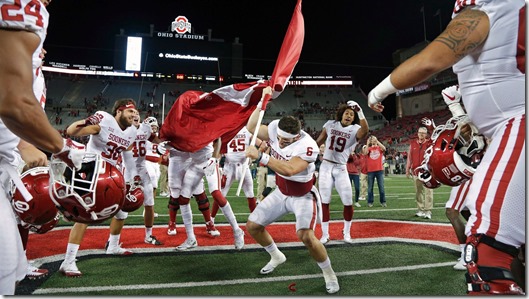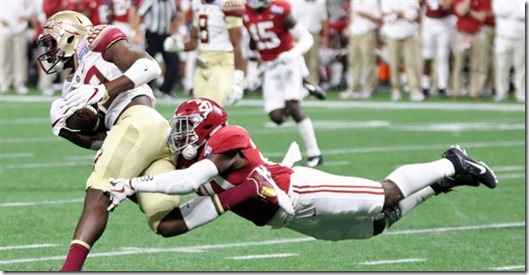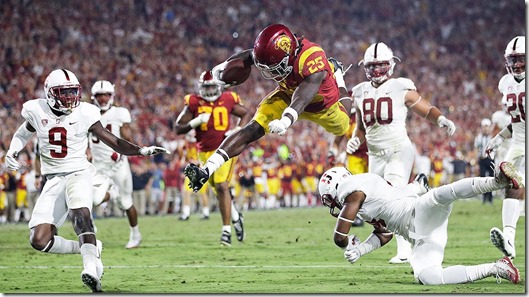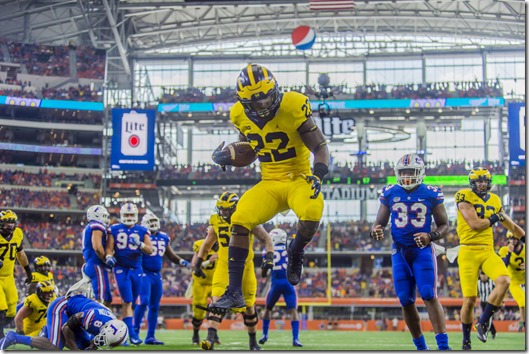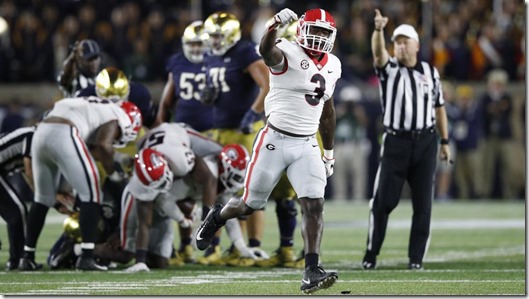Since I missed Week One due to my trip to Dallas, here’s a combined Week One / Two recap.
Early season matchups really only tell us about teams in relation to one another, so some of the conclusions drawn from these games could be disproven as the season progresses. Still, with a 12-game schedule and precious few matchups between top teams, there have been some valuable data points thus far. Here they are:
Oklahoma 31, Ohio State 16
A year after a very inexperienced Buckeyes team went into Norman and handled Oklahoma with ease, Lincoln Riley – a rookie head coach in his first marquee game – led OU to what wound up being a comfortable win after the Sooners pulled away in the second half. The game, which was tied 3-3 heading into halftime, was defined early on by Oklahoma’s inability to convert solid drives into points: they fumbled twice in Ohio State territory, were stopped on downs, and missed a field goal. Oklahoma’s offensive line had managed to corral Ohio State’s fearsome defensive line and OU quarterback Baker Mayfield was able to take advantage of a young OSU secondary to move the ball.
A Parris Campbell kick return in the second half gave the Ohio State offense the ball in Oklahoma territory to start the second half, and they took a 10-3 lead shortly thereafter. Mayfield and the OU offense caught fire after that, scoring touchdowns on four of their next five drives (including a series that saw the Sooners go 92 yards in just four plays), and they effectively ended the game early in the fourth quarter. Mayfield had the benefit of a veteran offensive line, but was working with newcomers in the receiving corps; OU’s top three targets in terms of receptions and yardage were a FB/H-Back, a Kentucky grad transfer, and a freshman. His most proven target – tight end Mark Andrews – left the game in the first half with an injury.
In the end, Mayfield posted an insane stat line against what was assumed to be one of the best defenses in college football: 27-of-35 passing for 386 yards, 3 touchdowns, and no interceptions. Nine different Sooners had at least one catch. Ohio State’s secondary had looked vulnerable in the opener against Indiana, but the Hoosiers did most of their damage by picking on young corners on throws up the sideline to taller wide receivers; Oklahoma didn’t run the ball efficiently (2.8 yards per carry), but they were able to set up the play-action and run-pass options that had OU receivers running wide open across the field against the Buckeye linebackers and safeties. Ohio State won’t see a playmaker of Mayfield’s caliber again in the regular season, but their pass defense is definitely a concern moving forward despite their terrific pass rush.
Oklahoma’s defense was lit up by JT Barrett and company in 2016, but they turned in an impressive effort on Saturday and held the Buckeye offense in check. OSU was able to run the ball decently enough – though OU didn’t concede a carry of longer than 16 yards – but their passing game was anemic: Barrett had just 5.2 yards per attempt and threw a pick. After the game, he received plenty of criticism for his inaccuracy downfield, but the Ohio State receivers weren’t able to create much separation and blame probably should be spread around – between Barrett, his targets, his line (which struggled against the Oklahoma front), and the coaches. The early returns on the Kevin Wilson hire have not been promising, as the former Indiana head coach (and Oklahoma offensive coordinator) hasn’t been able to rectify the issues that limited the OSU offense in 2016.
In the end, Oklahoma was clearly the better team. Mayfield is sensational and may be the best quarterback in the country (even next to Louisville’s Lamar Jackson), and the Sooner offense turned in an excellent effort against the Buckeyes. They likely won’t be challenged until late October at least, and while a trip to Stillwater to face an explosive Oklahoma State squad looms late in the season, they’re the clear favorites to win the Big 12 and will be in the playoff race until the end unless something catastrophic happens. As for Ohio State, it was pretty much a nightmare: their potential weaknesses entering the season have been confirmed as serious liabilities (against great teams, at least), and while they still have more talent than any team they’ll face in the regular season, Barrett’s arm and the secondary’s inexperience could cost them again. They might not need to run the table from here to make the playoff, but the margin of error is now very slim.
[Much more on the season’s big games after the JUMP]
Alabama 24, Florida State 7
This was the other early-season game featuring two teams that were playoff frontrunners, and it was a slog, as both blue chip-laden defenses were dominant. Florida State ran for just 40 yards; Alabama only threw for 96, and 53 of those came on a play-action touchdown on a post route to Calvin Ridley. Neither team made it to 270 yards of total offense, and both were a combined 7-29 on third down conversions. Both front sevens controlled the line of scrimmage and flew around making plays: Florida State’s defense was as good as advertised and Alabama’s looked like they had picked up right where the ridiculous 2016 unit had left off, despite the attrition of several stars. The Seminoles were more or less content to play an Alabama-style game; in the Nick Saban era, that’s meant low-scoring defense-oriented contests in which the Tide slowly but surely chokes out their opponent after a couple of big plays.
Those big plays came on special teams. Even though both teams had multiple errors in that phase of the game, Florida State’s were more devastating. Following a blatant uncalled pass interference penalty All-American corner Minkah Fitzpatrick blocked an FSU field goal at the end of the first half. Early in the third quarter, running back Damien Harris blocked a punt deep in Florida State territory (and the FSU defense managed to hold Bama to a field goal). On the ensuing kickoff, Keith Gavin had trouble with the kickoff near the goal line and fumbled it near the ten-yard line – Harris ran it up the gut for a touchdown to make it a two-score lead. Bama missed two field goals themselves, but ultimately the big plays by the Tide on special teams led directly to a 14-point swing and enabled their defense to suffocate Florida State in the fourth quarter.
Following the Harris touchdown, Florida State’s Deondre Francois threw interceptions on two consecutive drives after playing pretty well up to that point: he’d led a methodical touchdown drive through the air earlier in the game (though he did only account for 6.4 yards per attempt on the game). Francois, who survived a ton of hits behind a mediocre offensive line in 2016, was sacked late in the game and suffered a season-ending injury to his patellar tendon. That loss may have spelled the end of the Seminoles’ playoff hopes, as the drop-off from Francois to whoever winds up replacing him is sure to be stark. Had he not been injured, Florida State looked like they could have run the table the rest of the way (against a very tough schedule) and won the ACC, but their nasty defense might not be enough to avoid at least another loss or two.
Alabama’s lack of offensive success in this game could be reason for concern. Outside of the bomb to Ridley, Jalen Hurts went 9 of 17 for just 43 yards – and even though he looked fine throwing the ball in a perfunctory blowout against Fresno State on Saturday, Saban gave some snaps to freshman quarterback Tua Tagovailoa in the second quarter. Hurts is a talented runner (he ran for 154 yards and two touchdowns in that Fresno State game), but was unable to find open receivers against the Seminoles. Alabama may not have to rely on his arm much – if they do, there will probably be issues. Ridley was the only wide receiver to catch a pass against Florida State. FSU has an elite defense, but Bama also has to face LSU and Auburn, two teams that could possibly hold their own against the Tide’s rushing attack. Bama’s still easily the SEC favorite because of their defense: based on what we’ve seen thus far, it’s probably the best in the country or very close to it.
Clemson 14, Auburn 6
Another early-season matchup between highly ranked teams devolved into a slugfest as Clemson took care of Auburn behind a ferocious defensive performance. On the first drive of the game, Auburn marched down the field on a 15-play, 69-yard drive that stalled out inside the five-yard line after running back Kamryn Pettway converted a fourth-and-short, but they weren’t able to punch the ball in for a touchdown and had to settle for a field goal. After the two teams traded punts, Auburn forced and recovered a fumble deep in Clemson territory, but had to kick another field goal as the Clemson defense held up despite the short field. From there, the Tiger defense totally overwhelmed Auburn: only one drive lasted longer than ten yards and Gus Malzahn’s offense was held scoreless the rest of the way.
Over half of Auburn’s total yardage came on the first yard of the game, as they were held to just 117 yards. Quarterback Jarrett Stidham was sacked eleven times by Clemson: he held on to the ball too long in the pocket, was unable to avoid the pass rush, and his offensive line was totally overwhelmed by the Clemson front. Junior defensive end Austin Bryant had four sacks of his own, and he and the rest of the Tiger front harassed Stidham into a miserable game: he had just 79 yards passing on 24 attempts and was unable to pose an effective run threat. Pettway – one of the better backs in the SEC – was held in check, totaling 3.4 yards per carry on the night.
To their credit, Auburn’s defense also played quite well, though holding Clemson to 14 points wasn’t enough. Clemson quarterback Kelly Bryant led two long scoring drives at the end of the first half and the beginning of the second; long passes to Ray-Ray McCloud (who had the fumble earlier in the game) put the Tigers in position to score, and Bryant ran for the only two touchdowns of the game – the first on a nifty fake inverted veer, the second on a 27-yard scamper after breaking a tackle. Clemson’s offense wasn’t great, but they didn’t really need to be. Bryant was briefly injured early in the game – staying down for a while and putting a scare into the home crowd – but ultimately he recovered and played well enough to give the defense enough breathing room to get the win. The dropoff from former star quarterback Deshaun Watson has been significant, but perhaps Clemson will be able to win with defense instead of offense more frequently in 2017.
That defense will face a much stiffer test next week as the Tigers head to Louisville to take on the reigning Heisman winner Lamar Jackson, as Jackson lit up Clemson in a shootout loss in 2016 – and they travel to Blacksburg to take on Virginia Tech two weeks after that. If anything, Clemson’s defense appears to have improved from last season: the defensive line looks to be the best in the country and should be able to control the line of scrimmage and harass opposing quarterbacks in every game from here on out. On the other side, it’s clear that the addition of Stidham wasn’t a panacea for the ailing Auburn offense, and while coordinator Kevin Steele’s defense looks to be as good as ever, Malzahn’s reputation as an offensive guru has taken a substantial hit over the last few seasons. The Tigers have a few relatively easy games coming up to get back on track, but it’s hard to envision their offense having much success against some of their SEC West opponents (and Georgia).
USC 42, Stanford 24
The first high-profile intra-conference matchup of the season came from the Pac-12, as USC hosted Stanford and destroyed the Cardinal defense en route to what wound up being a comfortable win. The Trojans had looked shaky in their opener against Western Michigan – a game that was close well into the fourth quarter – but was firing on all cylinders on Saturday: star quarterback Sam Darnold threw for 316 yards and four touchdowns and USC ran the ball extremely well – they reached 307 yards rushing as a team as both halves of their running back platoon (Stephen Carr and Ronald Jones) each made it over 100 yards on the game. A few Darnold picks and a spate of Trojan penalties prevented this from being a blowout, but it was an extremely impressive showing from the USC offense against what was perceived to be a stout Stanford defense.
After a Cardinal punt on the first series of the game, the next five drives between the two teams resulted in touchdowns: USC’s first two were long, methodical marches down the field; Stanford scored their first TD on a well-blocked toss play that saw Bryce Love outrun the USC defense for a 75-yard touchdown and their second came on a short field following a kick return out to near midfield. From there, the Trojan defense was able to hold its ground against the bruising Stanford running game and – outside of that touchdown run by Love – kept the Cardinal under four yards per carry on the game. Keller Chryst played decently enough under center for Stanford and they didn’t turn the ball over, but the Cardinal couldn’t keep up with the Trojans in the end.
USC had lost thrice to Stanford in the past two seasons, the Trojan offense was phenomenal across the board on Saturday. The line controlled the Stanford front all game and USC was able to run the ball between the tackles with ease; wide receivers Deontay Burnett and Steven Mitchell made some spectacular plays and scored two touchdowns each; Darnold completed 81% of his passes; Carr and Jones each had plenty of success knifing through the Cardinal defense – and Jones sealed the win in the fourth quarter with a 23-yard touchdown on third down that ended with him flying over a defender into the end zone. Their balance was perhaps what was most impressive: Darnold is the headliner and rightfully a well-hyped NFL prospect, but the Trojans were also quite successful on the ground, churning out 6.4 yards per carry against Stanford’s good (possibly great) run defense.
Any lingering concerns from USC’s underwhelming opener are gone now, and the Trojans seem to be the clear favorites in the Pac-12. They just passed what was projected to be their toughest test of the regular season with flying colors, and while there are some potentially tricky road games on the horizon (most notably against Washington State), USC would avoid a matchup with Washington unless they play them in the conference championship game. Along with Alabama and Oklahoma, the Trojans are decidedly a playoff frontrunner at this point. Stanford still has a decent shot of winning the Pac-12 North and forcing a rematch with USC, but they’ll almost definitely need to beat Washington in November to make that happen.
[Chris Cook – MGoBlog]
Week One
- Michigan 33, Florida 17. In the end, two pick-sixes from the Florida defense were the only reasons why this game was close well into the fourth quarter, as Michigan kept the Florida offense off the board following a field goal on the opening drive. The Wolverines were able to move the ball well enough – the running backs bounced outside effectively on several running plays and Wilton Speight was mostly decent outside of a horrendous throw on the second interception. It remains to be seen exactly how dysfunctional Florida’s offense is – their Week Two game was canceled because of Hurricane Irma – but it appears as if Michigan once again has an elite defense despite having almost entirely new starters on that side of the ball. Don Brown’s a genius. A somewhat lackluster win over Cincinnati on Saturday may have temporarily slowed the hype train, but Michigan looks to be a major factor in the highly competitive Big Ten East. Jim McElwain’s getting plenty of criticism following that lackluster opener; if Florida doesn’t turn things around quickly (starting with a rivalry game against Tennessee this weekend), his job security may be in question.
- Virginia Tech 31, West Virginia 24. A resurrected rivalry provided a great matchup, as the Hokies were able to pull ahead midway through the fourth quarter for the win. Redshirt freshman quarterback Josh Jackson (son of former Michigan running backs coach Fred Jackson) was terrific in his debut: he threw for 235 yards and a touchdown, ran for 101 yards and another, and had a long run up the middle that set up the game-winning touchdown. After an uneventful first half, things picked up in the second: after WVU tied the game up in the third, a long Hokie kick return set up a Jackson passing touchdown to Cam Phillips on the next play; after the two teams traded punts, a Will Grier bomb to Gary Jennings tied the game back up early in the fourth. Virginia Tech missed a field goal that would have sealed the game and West Virginia marched the ball down the field, but they ran out of timeouts and the game ended with an incompletion from the 15-yard line. Both teams acquitted themselves well in this game and took care of their Week Two non-conference opponents.
- UCLA 45, Texas A&M 44. In what may stand as the most bizarre game of the 2017 season, Texas A&M raced out to a huge lead on the road against UCLA before conceding touchdowns on the final five Bruin drives – the last a fake spike fade with less than a minute left in the contest – to lose by a single point. It was a matchup between two coaches on the proverbial hot seat, and it looked like A&M was on its way to a rout before completely imploding down the stretch. Despite running the ball effectively with Trayveon Williams and backup Keith Ford all game, Kevin Sumlin still dialed up some passing plays during that meltdown – and A&M finished with a combined 9-of-30 passing for just 89 yards between their two quarterbacks. UCLA’s Josh Rosen was masterful during the comeback: he threw for 491 yards and four touchdowns on the game. This game was compelling for several reasons: the coaches’ lack of job security, the completely different (but mostly one-dimensional) offenses, and the epic collapse/comeback that may define each team’s season.
- Tennessee 42, Georgia Tech 41 (2OT). The last game of the season’s opening weekend was a classic: despite being outplayed for most of the game, Tennessee was able to come back and force overtime, and they stuffed Georgia Tech for what seemed like the first time all game on a do-or-die two-point conversion attempt to end the game in double overtime. The Vols were able to find some success offensively after they started running the ball more with John Kelly (who finished with four touchdowns) and targeting Marquez Callaway in the passing game, and they overcame a shaky start from new quarterback Quinten Dormady. Georgia Tech missed some opportunities that could have sealed the game in the second half: they missed two field goals (including one at the end of regulation) and fumbled the ball in Tennessee territory. Quarterback TaQuon Marshall turned in a heroic performance in defeat – 44 carries for 249 yards and 5 touchdowns – but kept the ball instead of pitching it on that game-deciding two-point conversion at the very end.
Week Two
- Georgia 20, Notre Dame 19. Despite being forced to play their backup quarterback – a true freshman – in his first road start, Georgia was able to get past Notre Dame by a single point in South Bend after a late chip shot by kicker Rodrigo Blankenship late in the fourth quarter. The Bulldog defense was excellent: they harassed Irish quarterback Brandon Wimbush all game (and forced a sack fumble on Notre Dame’s final drive of the night to seal the win), held ND to just 55 yards rushing, and were able to force field goal attempts once pushed back into their own territory. Neither Georgia running back – Nick Chubb and Sony Michel – was able to find much room on the ground, but the Bulldogs ran the ball effectively enough to keep the pressure off of quarterback Jake Fromm. An absurd touchdown catch by Terry Godwin in the second quarter and a short touchdown run by Michel in the third capped long drives for the Bulldogs and helped them to the razor-thin win. Notre Dame’s inability to execute in the red zone is ultimately what doomed them.
- Penn State 33, Pittsburgh 14. In a rematch of the game that ultimately was what kept Penn State out of the playoff in 2016, the Nittany Lions exacted revenge against their in-state rivals and cruised to a comfortable win in Happy Valley. Two early receiving touchdowns by Mike Gesicki (one on a RPO, the other off play-action) helped open up a lead, and a long touchdown catch by Saquon Barkley in the third quarter gave PSU a commanding 21-3 lead. It was sort of a strange game: Pitt actually outgained Penn State and held onto the ball for almost two thirds of the game, but interceptions by Max Browne and an inability to convert long drives into points (they had one possession in the first half that took up 15 plays and eight minutes… and ended with a punt) killed any chances of Pitt pulling the upset. A Panther screen pass deep in their own end that wound up being a safety was an apt microcosm of how this one went.
- Louisville 47, North Carolina 35. After a closer-than-expected Week One win over Purdue (who might actually be decent), Louisville went on the road and got a big win in a cross-divisional ACC matchup against North Carolina. Lamar Jackson was terrific as usual: he threw for 393 yards and three touchdowns, ran for 132 yards and and three more, and his excellence was enough to hold off the Tar Heels. UNC was ineffective running the ball and lost quarterback Chazz Surratt to an injury during the game, but LSU transfer Brandon Harris stepped in and performed well, given the circumstances. Still, the Louisville offense was far too much for North Carolina to handle, as they totaled over 700 yards of offense and scored three straight fourth quarter touchdowns after UNC briefly took a one-point lead late in the third. With the postponement of Miami – Florida State on Saturday, Clemson – Louisville is definitely the best matchup of the weekend and it will be fascinating to see how Jackson (and perhaps more importantly, his offensive line) fares against the fantastic Tiger defense.
